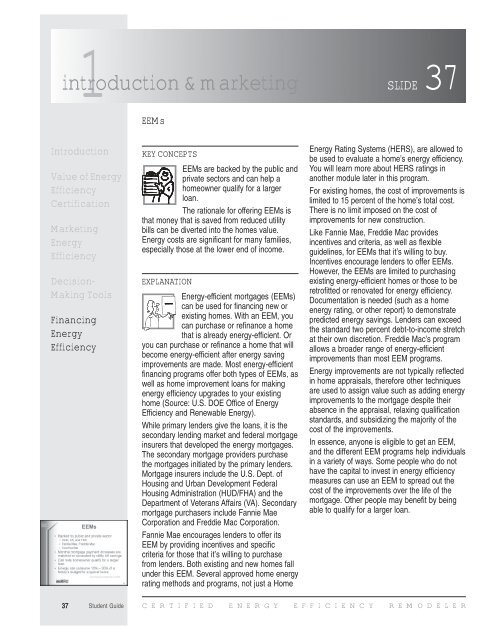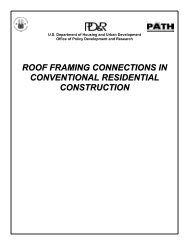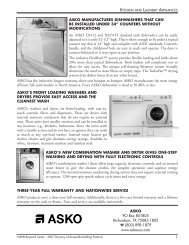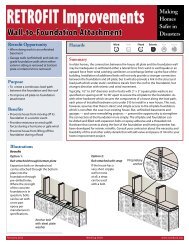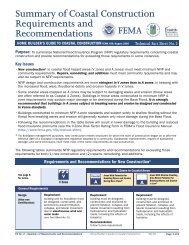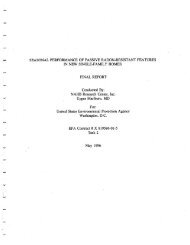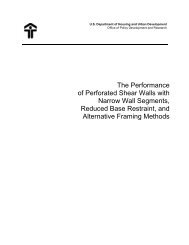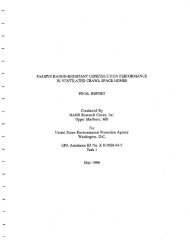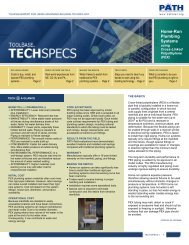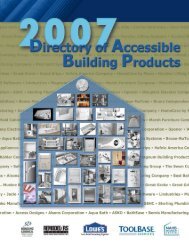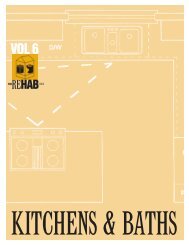Module 1 Student Guide - ToolBase Services
Module 1 Student Guide - ToolBase Services
Module 1 Student Guide - ToolBase Services
Create successful ePaper yourself
Turn your PDF publications into a flip-book with our unique Google optimized e-Paper software.
1 introduction & marketing 37<br />
SLIDE<br />
EEMs<br />
Introduction<br />
Value of Energy<br />
Efficiency<br />
Certification<br />
Marketing<br />
Energy<br />
Efficiency<br />
Decision-<br />
Making Tools<br />
Financing<br />
Energy<br />
Efficiency<br />
KEY CONCEPTS<br />
EEMs are backed by the public and<br />
private sectors and can help a<br />
homeowner qualify for a larger<br />
loan.<br />
The rationale for offering EEMs is<br />
that money that is saved from reduced utility<br />
bills can be diverted into the homes value.<br />
Energy costs are significant for many families,<br />
especially those at the lower end of income.<br />
EXPLANATION<br />
Energy-efficient mortgages (EEMs)<br />
can be used for financing new or<br />
existing homes. With an EEM, you<br />
can purchase or refinance a home<br />
that is already energy-efficient. Or<br />
you can purchase or refinance a home that will<br />
become energy-efficient after energy saving<br />
improvements are made. Most energy-efficient<br />
financing programs offer both types of EEMs, as<br />
well as home improvement loans for making<br />
energy efficiency upgrades to your existing<br />
home (Source: U.S. DOE Office of Energy<br />
Efficiency and Renewable Energy).<br />
While primary lenders give the loans, it is the<br />
secondary lending market and federal mortgage<br />
insurers that developed the energy mortgages.<br />
The secondary mortgage providers purchase<br />
the mortgages initiated by the primary lenders.<br />
Mortgage insurers include the U.S. Dept. of<br />
Housing and Urban Development Federal<br />
Housing Administration (HUD/FHA) and the<br />
Department of Veterans Affairs (VA). Secondary<br />
mortgage purchasers include Fannie Mae<br />
Corporation and Freddie Mac Corporation.<br />
Fannie Mae encourages lenders to offer its<br />
EEM by providing incentives and specific<br />
criteria for those that it’s willing to purchase<br />
from lenders. Both existing and new homes fall<br />
under this EEM. Several approved home energy<br />
rating methods and programs, not just a Home<br />
Energy Rating Systems (HERS), are allowed to<br />
be used to evaluate a home’s energy efficiency.<br />
You will learn more about HERS ratings in<br />
another module later in this program.<br />
For existing homes, the cost of improvements is<br />
limited to 15 percent of the home’s total cost.<br />
There is no limit imposed on the cost of<br />
improvements for new construction.<br />
Like Fannie Mae, Freddie Mac provides<br />
incentives and criteria, as well as flexible<br />
guidelines, for EEMs that it’s willing to buy.<br />
Incentives encourage lenders to offer EEMs.<br />
However, the EEMs are limited to purchasing<br />
existing energy-efficient homes or those to be<br />
retrofitted or renovated for energy efficiency.<br />
Documentation is needed (such as a home<br />
energy rating, or other report) to demonstrate<br />
predicted energy savings. Lenders can exceed<br />
the standard two percent debt-to-income stretch<br />
at their own discretion. Freddie Mac’s program<br />
allows a broader range of energy-efficient<br />
improvements than most EEM programs.<br />
Energy improvements are not typically reflected<br />
in home appraisals, therefore other techniques<br />
are used to assign value such as adding energy<br />
improvements to the mortgage despite their<br />
absence in the appraisal, relaxing qualification<br />
standards, and subsidizing the majority of the<br />
cost of the improvements.<br />
In essence, anyone is eligible to get an EEM,<br />
and the different EEM programs help individuals<br />
in a variety of ways. Some people who do not<br />
have the capital to invest in energy efficiency<br />
measures can use an EEM to spread out the<br />
cost of the improvements over the life of the<br />
mortgage. Other people may benefit by being<br />
able to qualify for a larger loan.<br />
37 <strong>Student</strong> <strong>Guide</strong> C E R T I F I E D E N E R G Y E F F I C I E N C Y R E M O D E L E R


